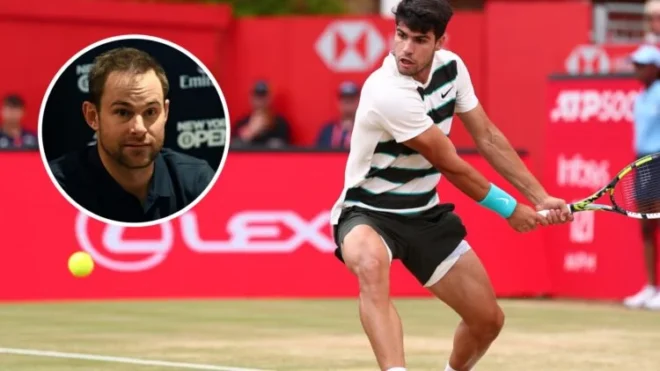
Andy Roddick says what Carlos Alcaraz does on grass which is just like Roger Federer and different to Rafael Nadal
1. Setting the Scene: Roddick, Alcaraz, and the Grass-Court Narrative 🏆
Andy Roddick, former world No. 1 and 2003 US Open champion, transitioned into media with his “Served with Andy Roddick” podcast. There, he’s offered sharp analysis comparing emerging talents to the legends he competed with. Recently, Roddick weighed in on Carlos Alcaraz, particularly highlighting his grass‑court gameplay—an arena where mastery demands precision footwork, low-bounce adaptation, attacking mentality, and mental acuity.
This discussion centers on Roddick’s view: Alcaraz—brimming with Federer‑like aggressiveness—is yet to refine Nadal‑like consistency. Understanding this requires exploring:
1. Roddick’s direct comparisons.
2. How Alcaraz plays on grass.
3. Key distinctions versus Nadal.
4. The bigger picture: where Alcaraz fits in tennis history.
—
2. Roddick’s Grass-Court Perspective: Alcaraz vs. Federer + Nadal
2.1 “He’s playing on his own terms” — like Federer
Roddick said on his podcast (as reported by Tennis365):
> “Alcaraz is like this insane thing to watch because he has all the shots and he can do everything, but he always takes his shot. With Roger, you always felt like you were playing on his terms … Alcaraz still makes way more errors than prime Federer, Nadal, and Djokovic, but most of the errors are on his terms. He’s trying to do something. He might miss a forehand wildly, but you’re going, ‘That was probably the right shot. He just missed it.’”
What this means:
Command over play: Like Federer, Alcaraz imposes his style—aggressive, attacking, dictating pace.
Calculated risk-taking: Errors come from assertiveness, not passive play.
Confidence in shot selection: He chooses high-impact shots even if risky, mirroring Federer’s natural assertiveness.
2.2 Error frequency: Energetic ambition vs. Federer’s precision
Roddick believes Alcaraz commits more unforced errors than Federer, Nadal, or Djokovic at their peaks. Yet:
Federer minimized mistakes, but often stayed within his aggressive framework.
Alcaraz has the same aggressiveness but with a younger player’s instinctual inconsistency.
Analytically, his game is built on intention—erring because he’s pushing, not because he’s out of sync.
—
3. Alcaraz on Grass: Learning from Federer and Murray
3.1 Watching Federer and Murray to master movement
Alcaraz has openly credited watching Federer and Andy Murray videos to adapt to grass movement. From AS USA and Sky Sports reports:
> “On grass, Roger and Andy for me are the best players that are moving great … I want to look up to the best players … I’m not talking about Djokovic because Djokovic slides like clay court … I try to put similar stuff in my game that Roger and Andy do on grass.”
Key takeaways:
No sliding: Grass demands different footwork; Alcaraz avoids clay-style sliding, learns from Federer and Murray’s grounded footwork.
Court coverage: He focuses on compact, sudden steps—mimicking their balanced, anticipatory movement.
Aggressive transition: Watching how they finish points at the net, he incorporates similar transition dynamics.
3.2 Adapting styles—what he incorporates
Inspired by Federer and Murray:
Federer: fluid footwork, seamless movement, attacking foot speed.
Murray: extraordinary defense, retrieving under pressure, low balls. Alcaraz blends these into a hybrid:
Aggressive baseline moves (Federer).
Retrieval reflexes (Murray).
Yet distinctively, he infuses his own aggressive flair.
Pointed exclusion of Djokovic:
Alcaraz noted Djokovic’s clay-style slides don’t translate to his style on grass .
Roddick’s podcast echoes this: Alcaraz plays aggressively, not defensively, contrasting Djokovic’s grit.
—
4. Comparisons with Nadal: Why it’s different
4.1 Nadal’s grass evolution vs. Alcaraz’s approach
Nadal, a baseline warrior with topspin dominance, took time to adapt to grass. He eventually won Wimbledon (2008–2010), using his power and stamina framed by grass adjustments.
But Roddick sees Alcaraz as not a Nadal clone:
Shot selection: Nadal’s grounded, spin-heavy, grinding rallies—Alcaraz tends toward aggression and fast points.
Mental consistency: Nadal brains on long tough matches; Alcaraz is still refining that relentless consistency.
Risk profile: Nadal was measured; Alcaraz is freer, bolder, more instinctual.
4.2 Roddick’s critique: greater errors but intentional
Roddick’s core observation:
Alcaraz’s errors come from ambition (“on his own terms”).
Nadal’s errors would come less, but also from conservative approach. Thus, Alcaraz resembles Federer’s fearless shot-making approach more than Nadal’s disciplined grind.
—
5. Broader Context: Elite comparisons and future promise
5.1 Djokovic’s take: Best of all worlds
Novak Djokovic called Alcaraz someone with:
Federer’s artistry.
Nadal’s fight and defense.
Djokovic’s adaptability and two-handed backhand .
As Djokovic said:
> “Basically got the best of all three worlds.”